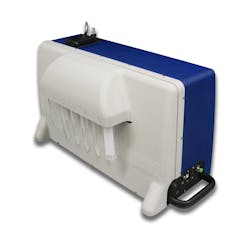Imaging biosensor from Bodkin Design features Class IIIb tunable laser
The Spectral Reflectance Imaging Biosensor is a multiplexed immunoassay platform for life science research and clinical diagnostics. It includes a Class IIIb tunable laser, high-resolution camera, fluidics, and digital control. It can simultaneously capture thousands of interactions and analyze them. It is designed for biomedical research, pathogen identification, and homeland security.
Bodkin Design and Engineering
Wellesley, MA
www.bodkindesign.com
-----
PRESS RELEASE
HEADLINE: Bodkin Design Helps to Launch New Product for Start-up Zoίray Technologies, Inc
NEWTON, MASSACHUSETTS
Bodkin Design & Engineering, LLC (BD&E) working with Boston University and Zoίray Technologies, Inc (Zoίray) has succeeded in converting their basic research into a commercial instrument. The Spectral Reflectance Imaging Biosensor (SRIB) is a multiplexed immunoassay platform for life science research and clinical diagnostics. Immunoassays that identify the presence of specific protein biomarkers in blood, urine, or
saliva constitute a vital tool in modern healthcare. Zoíray’s technology enables many immunoassays to be multiplexed on to one small disposable chip.
According to Dr. David A. Bergstein PhD, Founder and CEO of Zoίray, “Bodkin Design developed several approaches that balanced manufacturing costs, ease-of-use, and measurement sensitivity to arrive at the best solution for moving the protein array sensor to market.”
The final design incorporates a class IIIb tunable laser, high resolution camera, fluidics, and digital control. The system automatically carries out specimen delivery, reagent introduction, optical interrogation, specimen disposal and data analysis; all in a compact table top unit. During operation, a biochip containing active proteins is loaded into the device. The user then prompts the system to deliver the specimen and reagents to
the reaction flow cell, where incubation takes place. The sample is optically probed with the laser and evaluated. Thousands of interactions are captured simultaneously and analyzed using the built in camera and computer.
Key applications of the SRIB include biomedical research, disease pathogen identification and homeland security. For more information, visit www.zoiray.com.
Subscribe now to Laser Focus World magazine; it's free!
